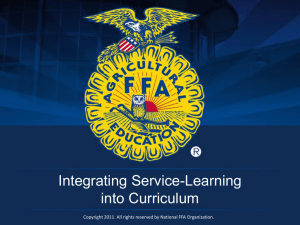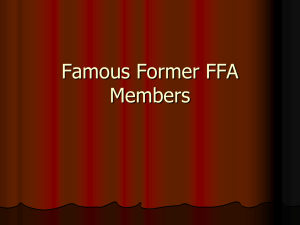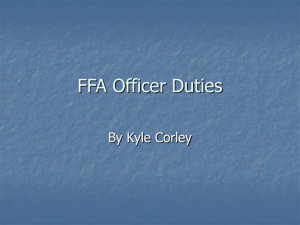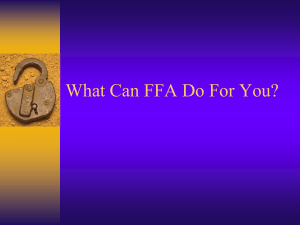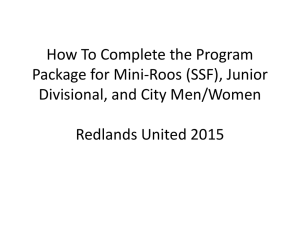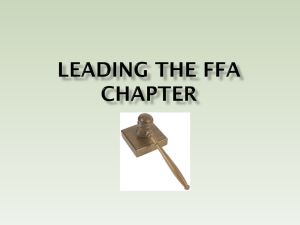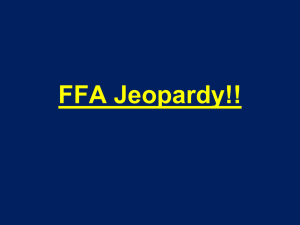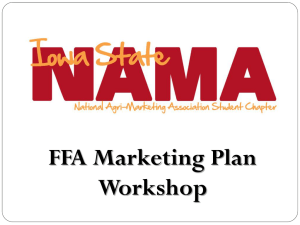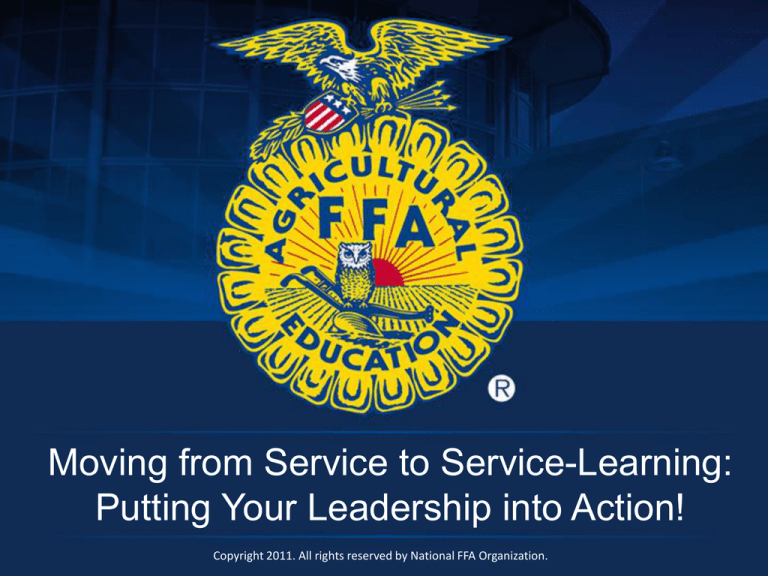
Moving from Service to Service-Learning:
Putting Your Leadership into Action!
Copyright 2011. All rights reserved by National FFA Organization.
Objectives
• Understand the differences between
community service, experiential learning
and service-learning
• Recognize the key elements of a servicelearning project
• Learn the benefits of utilizing servicelearning in agriculture programs
• Understand the steps to developing and
implementing a service-learning project
Copyright 2011. All rights reserved by National FFA Organization.
What is it?
Individually or with a neighbor,
decide if the scenarios are
community service, experiential
learning or service-learning.
You will have 5 minutes.
Copyright 2011. All rights reserved by National FFA Organization.
Similarities & Differences
Service-Learning
Community Service
Experiential Learning
Tied to Academics
NOT tied to Academics
Tied to Academics
Occurs over months or
Year
Often occurs only once
May happen once or
over the course of time
Structured reflection
No structured
reflection
Structured reflection
Youth Voice present
Often planned by
agency
Some Youth Voice
present
Focus on meeting a
community need
Meets a need
Focus is not meeting a
community need
Completed as a group
Completed as an
individual or group
Completed as an
individual or group
Copyright 2011. All rights reserved by National FFA Organization.
Service-Learning Key Elements
•
•
•
•
•
•
•
•
Meaningful Service
Link to Curriculum
Reflection
Diversity
Youth Voice
Partnerships
Progress Monitoring
Duration and Intensity
Copyright 2011. All rights reserved by National FFA Organization.
Revisit Scenarios
Now you will have 4 minutes to
reflect how you could turn one of
the scenarios into service-learning.
Be prepared to report out to the
whole group.
Copyright 2011. All rights reserved by National FFA Organization.
Benefits of Service-Learning
Copyright 2011. All rights reserved by National FFA Organization.
Benefits of Utilizing SL in Ag Classrooms
• Involves ALL students
• Students utilize their skills to plan and
carryout service projects and to meet unmet
community needs
• Another avenue to practice skills
• Creates CDE & SAE opportunities
• Students learn more about their community
and become more engaged
Copyright 2011. All rights reserved by National FFA Organization.
Additional Benefits to Students
National studies suggest that students
in effective service-learning programs:
• improve academic grades
• increase attendance in school
• develop personal and social
responsibility
Copyright 2011. All rights reserved by National FFA Organization.
Benefits of SL Beyond the Student
• Increases visibility of Ag programs within
the school and community
• Allows Ag teachers to create cross
curricular partnerships
• Opportunities for financial support
Copyright 2011. All rights reserved by National FFA Organization.
Ag. Ed. & Service-Learning
ServiceLearning
Copyright 2011. All rights reserved by National FFA Organization.
Service-Learning…
… should not be an add on, but a
strategy that helps you meet the
needs of your curriculum.
Copyright 2011. All rights reserved by National FFA Organization.
Service-Learning I-P-A-R-D Model
5 Steps Investigation
Preparation & Planning
Action
Reflection
Demonstration
Copyright 2011. All rights reserved by National FFA Organization.
Service-Learning I-P-A-R-D Model
Investigation
Copyright 2011. All rights reserved by National FFA Organization.
Investigation
• Identify the “community” to serve (world,
nation, state, or local)
• Assess community needs (e.g., based on
media reports, interviews, expert
presentations, etc.)
• Select a community need using criteria (e.g.
relevance to learning, urgency, importance,
student interest, and efficacy)
• Engage in reflection activities
• Start to develop a plan to assess learning
Copyright 2011. All rights reserved by National FFA Organization.
Types of Needs Assessments
•
•
•
•
Community Mapping
Walk About
Classroom Brainstorming
Informal Research like
reading the newspaper or
internet search
• Community partner
presents a need
Copyright 2011. All rights reserved by National FFA Organization.
Investigation - Activity
In groups of 3, scan the
newspapers that we passed out.
Identify an issue or need
highlighted in an article that you
could address with your class?
You will have 10 minutes.
Be ready to report out.
Copyright 2011. All rights reserved by National FFA Organization.
Service-Learning I-P-A-R-D Model
Preparation and Planning
Copyright 2011. All rights reserved by National FFA Organization.
Preparation & Planning
• Determine the nature of the service to
be provided
• Identify academic, civic, and other
learning goals
• Develop an action plan, timeline, and
budget
• Engage in reflection
• Develop and conduct assessment
Copyright 2011. All rights reserved by National FFA Organization.
Preparation & Planning
• What do you need to track to be successful?
o
o
o
o
o
Assignments & Grades
Service hours
Student engagement
Behavior issues
Community partners
Copyright 2011. All rights reserved by National FFA Organization.
Preparation & Planning - Activity
Working in your groups of 3 again,
use the need you decided on in the
last activity to brainstorm some of
the important components to
implementing a service-learning
project.
Copyright 2011. All rights reserved by National FFA Organization.
Preparation & Planning - Activity
Step 1 – Measurable Outcomes - begin
with the end in mind
• Yellow worksheet
• 8-10 minutes
• Write 2 measurable outcomes (Gray)
• Be prepared to report out to group
Copyright 2011. All rights reserved by National FFA Organization.
Preparation & Planning - Activity
Step 2 – Community Partners
• Light Green worksheet
• 5 minutes
• 4 partners, each from a different
group (Gray)
• Be prepared to report out to group
Copyright 2011. All rights reserved by National FFA Organization.
Preparation & Planning - Activity
Step 3 – Readiness
• Gray Worksheet
• 5 minutes
• 3-5 skills needed for students
• Be prepared to report out to group
Copyright 2011. All rights reserved by National FFA Organization.
Preparation & Planning - Activity
Step 4 – Resources
• Gray Worksheet
• 5 minutes
• 3-5 resources needed
• Be prepared to report out to group
Copyright 2011. All rights reserved by National FFA Organization.
Preparation & Planning - Activity
Step 5 – Timeline & Activities
• Gray Worksheet
• 10 minutes
• 8-10 time-bound activities
• Be prepared to report out to group
Copyright 2011. All rights reserved by National FFA Organization.
Preparation & Planning - Activity
Step 6 – Curricular Connections
• Light Blue Worksheet
• 10 minutes
• 12 activities tied to ag class
• Be prepared to report out to group
Copyright 2011. All rights reserved by National FFA Organization.
Service-Learning I-P-A-R-D Model
Action
Copyright 2011. All rights reserved by National FFA Organization.
Action
• The “heart” of the project:
engaging in a meaningful
service experience that will
help your students develop
important knowledge,
skills, and attitudes, and
will benefit the community.
The action occurs both in
the classroom and in the
field.
Copyright 2011. All rights reserved by National FFA Organization.
FFA SL Projects in Action!
• Waldo County FFA (ME)
– Technical Center
– Partnered with local college agriculture students to help
fight hunger
• Sidney FFA (MT)
– Partnered with other CTE classes to develop, implement,
and maintain a city-wide recycling program
• West Central FFA (SD)
– Developed a website and all program handouts (flyers,
brochures, etc.) as part of their Ag. Comm. Class/CDE
Copyright 2011. All rights reserved by National FFA Organization.
Copyright 2011. All rights reserved by National FFA Organization.
Service-Learning I-P-A-R-D Model
Reflection
Copyright 2011. All rights reserved by National FFA Organization.
Reflection
Activities that help students
understand the service-learning
experience and to think about its
meaning and connection to them,
their society, and what they have
learned in school. Reflection also
serves as a form of evaluation.
Copyright 2011. All rights reserved by National FFA Organization.
Reflection
Reflection is On-Going
• Pre Reflection: prepares
participants for the project
• Active Reflection: occurs in the
field and requires critical thinking
• Post Reflection: is used as an
evaluation tool
Copyright 2011. All rights reserved by National FFA Organization.
Reflection - Activity
Using Gardner’s
theory of multiple
intelligences,
create a way to
reflect BEFORE,
DURING, and AFTER
a project that ties to
at least two
different areas of
the model.
Copyright 2011. All rights reserved by National FFA Organization.
Service-Learning I-P-A-R-D Model
Demonstration
Copyright 2011. All rights reserved by National FFA Organization.
Demonstration
• Participants publicly demonstrate their
knowledge gained and
accomplishments achieved through the
service-learning project.
Copyright 2011. All rights reserved by National FFA Organization.
Q&A
Resources:
www.ffa.org/livingtoserve
www.servicelearning.org
Contact:
Stefonie Sebastian – ssebastian@ffa.org
Michele Sullivan– msullivan@ffa.org
Copyright 2011. All rights reserved by National FFA Organization.

